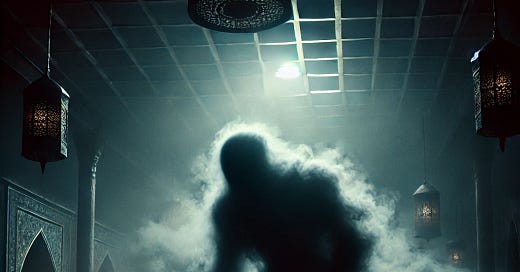Myth of the Day: Bakhtak
Explore the Bakhtak's nocturnal reign in Iran's folklore, inducing nightmares and sleep paralysis, yet repelled by dream-protecting amulets.
Region/Culture: Iran, Asia
Mythos: Persian Mythology
Primary Type/Nature: Demons and Devils
Mythical Attributes: The Bakhtak is said to induce nightmares by sitting on a sleeper’s chest.
Role in Mythos: Primarily known for causing nightmares and sleep paralysis.
Relation to Humans: The Bakhtak often targets humans during their sleep to induce nightmares, and its presence is considered an omen of bad luck or malevolent forces.
In the deepest corners of the night, when the moon is hidden behind a shroud of cloud, a mysterious figure roams the sleepy chambers of Iran. This creature, ethereal and yet unsettlingly solid, is known as the Bakhtak. Hailing from the intricate tapestry of Persian mythology, this enigmatic entity falls under the realm of demons and devils, though it uniquely specializes in the arena of sleep and dreams—or rather, nightmares.
Picture this if you will: a figure as nebulous as the night itself. In form, the Bakhtak resembles a shadow, but not the harmless silhouette a tree might cast on a quiet street. This shadow has weight, substance, a dark density that makes the air around it feel thicker, as if you’re trying to breathe through a woolen blanket. When it manifests, it typically appears as a shadowy, amorphous figure, bearing down upon you with a weight so palpable that it can induce the unmistakable feeling of chest pressure. One might argue that it embodies the corporeal essence of dread. For those who have experienced its visitations, the Bakhtak doesn’t just sit on the chest; it sits on the soul.
The origin of the Bakhtak is as mysterious as the creature itself, an enigma shrouded in the annals of Persian folklore. Primarily, it’s known for causing nightmares and sleep paralysis. But why, you ask? Ah, the heart of Persian myths rarely deal in the trivialities of ‘why,’ but rather the complexities of ‘is.’ Its existence and purpose serve as a reminder of the precarious balance between the realms of the known and the unknown, the waking world and the land of dreams, good fortune and imminent calamity.
Now, to the tale most told about the Bakhtak. In the ancient city of Persepolis, where kings once dreamt of eternal rule, a humble weaver named Kurosh experienced a series of nightly visitations. Each night, as Kurosh laid his head to rest after a long day of labor, he found himself imprisoned in his own nightmares, crafted meticulously by the Bakhtak. From labyrinthine mazes to bottomless pits, Kurosh faced terrors beyond mortal comprehension. It was only after seeking the wisdom of a local soothsayer that Kurosh managed to escape his nocturnal torments. He placed an amulet, infused with the essence of sweet dreams, under his pillow. The Bakhtak, finding itself unable to pierce through the amulet’s aura, eventually retreated into the depths of folklore, though never truly vanishing.
When it comes to abilities, the Bakhtak has a singular, focused expertise: it induces nightmares. It need not touch you, nor speak incantations. Its mere presence, its weight upon your chest, is enough to lead your sleeping mind down twisted corridors of fear. Yet, despite its seemingly unstoppable nature, the Bakhtak has its limitations. The creature appears to be repelled by certain talismans or amulets, often of a religious or magical nature. It’s as if the concentrated essence of positive energy acts as anathema to this being, which thrives in the soil of human fears.
So, the next time you find yourself tossing and turning, restless in the ink-black hours before dawn, spare a thought for the Bakhtak. It serves as a testament to the age-old notion that our myths and legends are born from the inky depths of human psyche, ever so reflective of our dreams and, indeed, our nightmares.
Suggested Further Reading
Explore more myths and wonders by visiting godsandmonsters.info.
Enjoy mythic tales on the move with our podcast, Five Minute Mythology.





